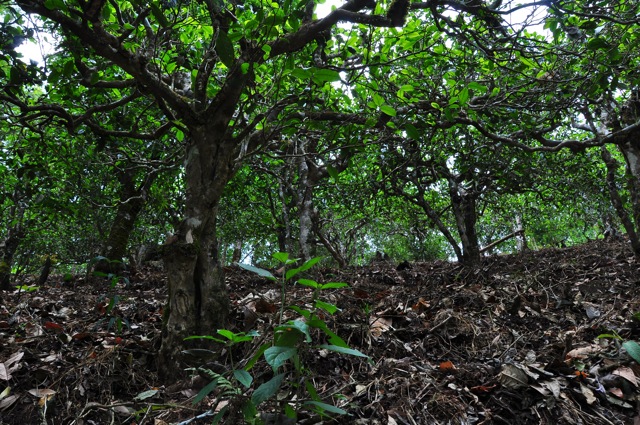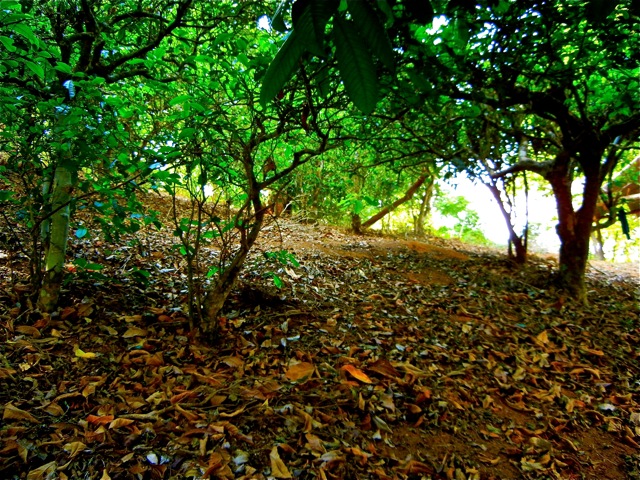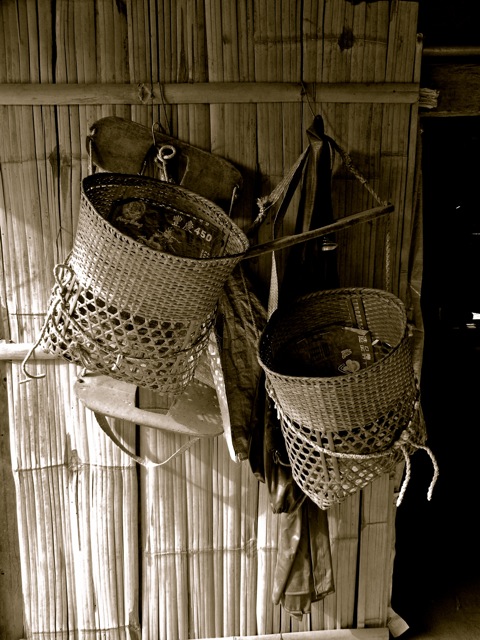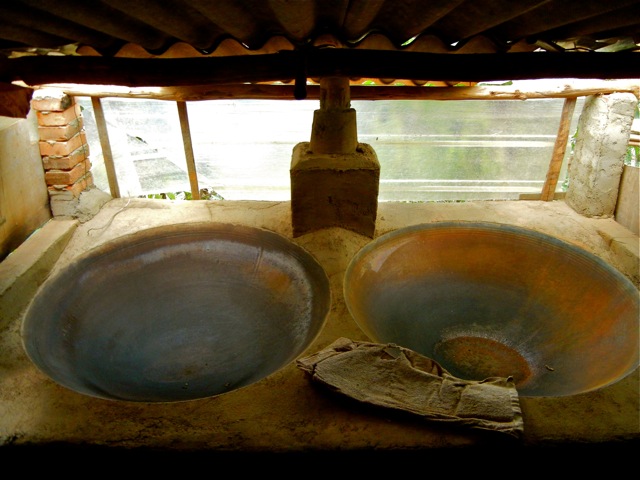Teashops and tea cups have to at some point make way for the tea forests and fields. Fluid must give way to its ‘source’. As much as my entire being loves to be shoved into a tight little shop sipping to the tongue’s contentment, the body needs to move to smell and feel the land that provides the magic fertility that allows the tea plants and trees to grow.
The cup of tea with its tastes, strengths (or lack thereof) and hues mean very little without a look at where it comes from and who live alongside it.
Nannuo Mountain and its various villages offer up mountains, tastes, soil types and the full range of making tea. Paths line the mountains, jigging up into ever-higher tea forests, dropping down into valleys and plunging deeper into the mountains. Villages burble along with little interrupting the slow pace and thankfully little interrupting the flow of tea from the mountains into the cups.

No tea discussion can take place without the inclusion of the locals who live with, sip and benefit from the green leaf
I am walking on one particular path near Pa San – an area that produces one of the subtlest of all Pu’erhs. Nannuo has always been known for its ‘lighter’, less astringent Pu’erhs, which is partly to do with the soil and partly the process. I’m in good company as my companion is none other than Mr. Gau, a tea maker of stupendous teas from the famed Banzhang area further west. He is here and is curious about the area and its teas as I am, and there is no one the globe that I would rather have on a tea mission that him. Soft spoken (to the point that I must strain and stop all movement to hear him at all), understated, and entirely into the soil, trees and conditions that give teas their flavour, Gau often stops to point, to prod or to simply stare.
He is at peace in the forests and is as content as I am poking about. Villages of Hani (Akha) dot our path as we wander wherever our feet and urges dictate…and that makes for some interesting turns without warning.
The soil in this region is sandy and reddish in tint, and Gau explains how the angled slopes, the bamboo cover and soil type all contribute to ideal conditions. Like the magnanimous tea-god that he is, he is generous with ‘competitors’ and tea regions other than his own. Being of the Hani people himself, he wanders into villages at will, speaking in his soft voice. When discovering where he is from, villagers themselves become silent; his home is the most famous of all Pu’erh towns in Yunnan. Gau pokes about the homes in his ambling gentle way explaining to me what each tea accoutrement is, and why many of the indigenous areas “do better tea”. For Gau, it is simple: an unchanged method of production and doing things by hand keep things predictable and keeps the tea quality high. On one wall hanging casually, two tea baskets with their accompanying wooden harnesses that are fitted around the neck like ancient battle gear.
In one home a withered man sits on a stool sorting through tea leaves with a kind of ritualistic slowness that only the people of the land seem to have. Gau speaks to him in the nasally tones of his language and in a touching show of complicity squats with him on the floor sorting through the dry leaves.
Later, we wander down from the elevated home back to the first floor. Pushing a door in we enter into a darkened tea sanctum. It is where the tea is ‘made’. Two immaculate pans sit next to one another and a tea roller hovers in a corner of shade. Much here rests silent as the last of the spring harvests has just been taken in.
We are eventually pointed up a path from the home into an area where, according to the tea sorter, the locals have been planting the “children of ancient tea trees” in little rows in a bamboo forest. They are the future of the tea forests and as long as the villagers don’t ruin the surrounding and necessary forests, the mountains and its teas will be safe…and by a nice extension the future will be safe.
We find the ‘babes’ just as we were told we would. To get here we head up and up, sliding in the dry sandy soil and leaves, and even getting down on our hands and knees at times. In an endearing bit of rural habit in China, Gau is wearing some dress shoes, which provide no traction whatsoever. It offers up a bit of contrast as Gau has hands of the countryside: big, callused, things that are competent and wide.
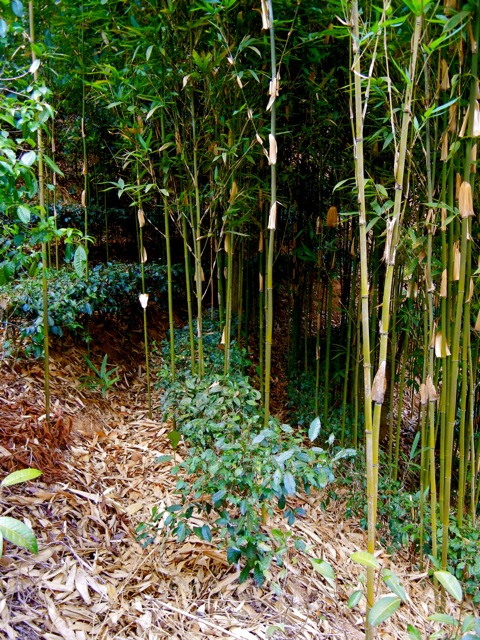
Lying within the safe and nutritious realm of the surrounding forest, young tea plants have a secure future
Reaching the little newbie’s which are lined one by one between a thatch of bamboo. The placement isn’t precise or even neat, but rather casual and intuitive. Gau tells me how this is ideal not only for the shading for the little tea plants but also for the way that each tree will have ample space to grow in the future.
In an impulsive moment as Gau squats over a young tea plant, he looks up suddenly and asks if where I’ll source teas from. I tell him that his teas are too pricey – at which point he cuts in with a smile telling me that there isn’t any more of his tea to source anyways – and that I like the Nannuo region as I feel it has always suffered from being an underrated area. Each village produces teas, and within that village, families with their own little tea operations season-after-season and year-after-year hum along, producing their own version of tea. Many towns and ‘mountains’ within the greater Nannuo area produce teas and it remains one of the classic ‘tea mountains’ in Yunnan lore. A tea simply bearing the name “Nannuo Mountain” means nothing. Nannuo Mountain teas should all be traceable to a village or specific region within the greater area and should carry the designation “old tree tea”, or “young tea tree”. Teas without this information aren’t complete or reliable.
Gau is nodding in the mountain heat in apparent agreement. He tells me simply, “Do it”, and with that we go higher. “You don’t need to buy my tea”, he tells me later, and “I’ll share with you”. I’m wishing that this sharing can happen now as it has been two hours since our last ‘infusion’.
Everything about the area that we are in speaks of simplicity. Steps have been carved into the earth to access small terraces of reckless tea growth. Barely visible paths poke through, the green wall of trees heading deeper still into tea forests. There is a hushed quiet that is cut only by cicadas that whine and grind their tunes into the hot air.

Ready for consumption, the tea leaves are edited one last time so that they 'look good' for the markets
Gau at one point has had enough and turns and tells me that he is “thirsty”. Somewhere below us – though we’re not sure where – a tea awaits.

